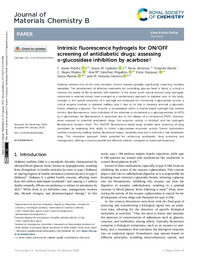Please use this identifier to cite or link to this item:
https://hdl.handle.net/11000/35671Full metadata record
| DC Field | Value | Language |
|---|---|---|
| dc.contributor.author | Patiño, F. Javier | - |
| dc.contributor.author | Galindo, Josué M. | - |
| dc.contributor.author | Jiménez, Alicia | - |
| dc.contributor.author | Alacid Martínez, Yolanda Inmaculada | - |
| dc.contributor.author | Mateo, C. Reyes | - |
| dc.contributor.other | Departamentos de la UMH::Agroquímica y Medio Ambiente | es_ES |
| dc.date.accessioned | 2025-02-18T08:40:50Z | - |
| dc.date.available | 2025-02-18T08:40:50Z | - |
| dc.date.created | 2025-01 | - |
| dc.identifier.citation | Journal of Materials Chemistry B | es_ES |
| dc.identifier.issn | 2050-7518 | - |
| dc.identifier.uri | https://hdl.handle.net/11000/35671 | - |
| dc.description.abstract | Diabetes remains one of the most prevalent chronic diseases globally, significantly impacting mortality ratetables. The development of effective treatments for controlling glucose level in blood is critical to improve the quality of life of patients with diabetes. In this sense, smart optical sensors using hydrogels, responsive to external stimuli, have emerged as a revolutionary approach to diabetes care. In this study, changes in the optical properties of a hydrogel are employed for monitoring a-glucosidase activity, a critical enzyme involved in diabetes mellitus type II due to its role in breaking terminal a-glycosidic bonds, releasing a-glucose. The enzyme is encapsulated within a triazine-based hydrogel that exhibits intrinsic blue fluorescence. Upon hydrolysis of the substrate p-nitrophenyl-a-D-glucopyranoside (p-NPG) by a-glucosidase, the fluorescence is quenched due to the release of p-nitrophenol (PNP). However, when exposed to potential antidiabetic drugs, the enzyme’s activity is inhibited, and the hydrogel’s fluorescence remains intact. This ON/OFF fluorescence-based assay enables rapid screening of drug candidates by evaluating their ability to inhibit a-glucosidase enzymatic activity. Sensor optimization involves conducting swelling studies, fluorescent assays, reusability tests and a trial with a real antidiabetic drug. This innovative approach holds potential for enhancing antidiabetic drug screening and management, offering a more accessible and efficient solution compared to traditional biosensors. | es_ES |
| dc.format | application/pdf | es_ES |
| dc.format.extent | 8 | es_ES |
| dc.language.iso | eng | es_ES |
| dc.publisher | The Royal Society of Chemistry | es_ES |
| dc.rights | info:eu-repo/semantics/openAccess | es_ES |
| dc.rights | Attribution-NonCommercial-NoDerivatives 4.0 Internacional | * |
| dc.rights.uri | http://creativecommons.org/licenses/by-nc-nd/4.0/ | * |
| dc.subject.other | CDU::5 - Ciencias puras y naturales::54 - Química | es_ES |
| dc.title | Intrinsic fluorescence hydrogels for ON/OFF screening of antidiabetic drugs: assessing a-glucosidase inhibition by acarbose† | es_ES |
| dc.type | info:eu-repo/semantics/article | es_ES |
| dc.relation.publisherversion | 10.1039/d4tb02466d | es_ES |

View/Open:
paper publicado.pdf
1,68 MB
Adobe PDF
Share:
.png)
